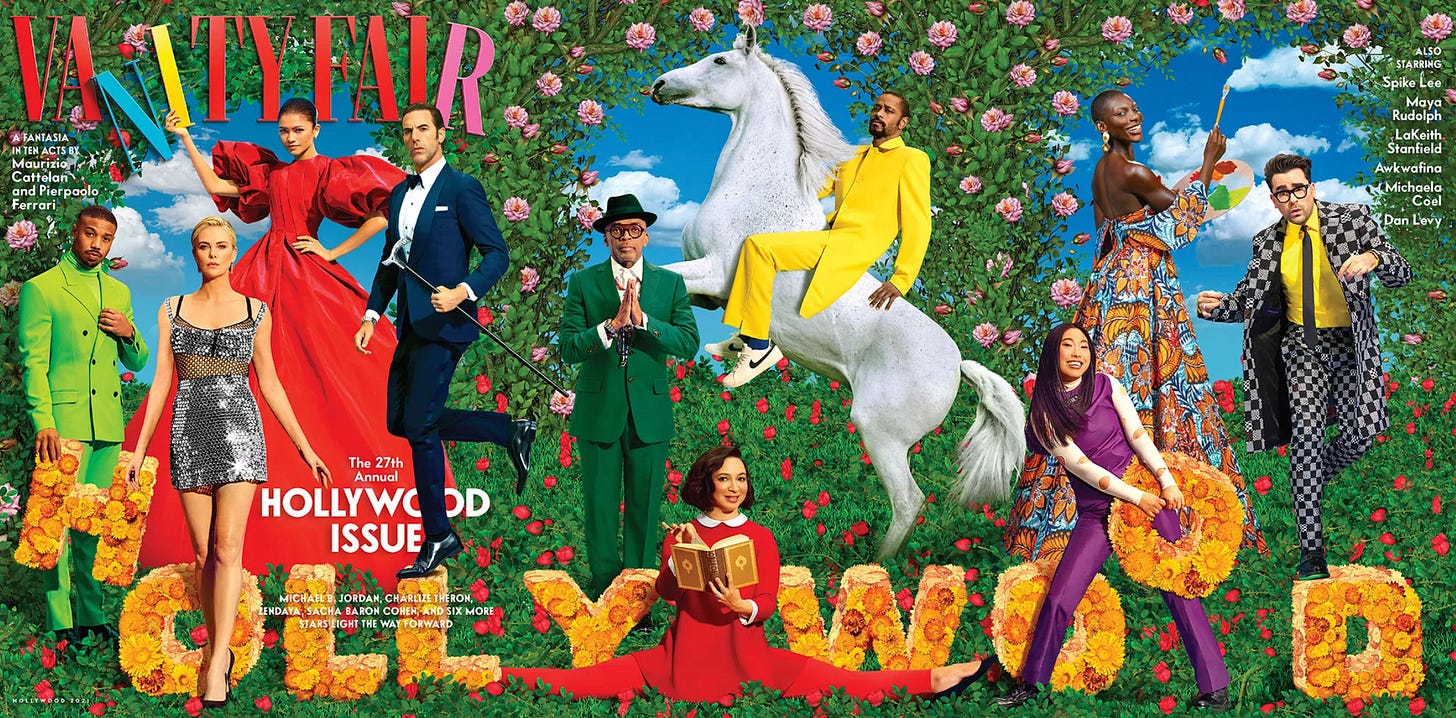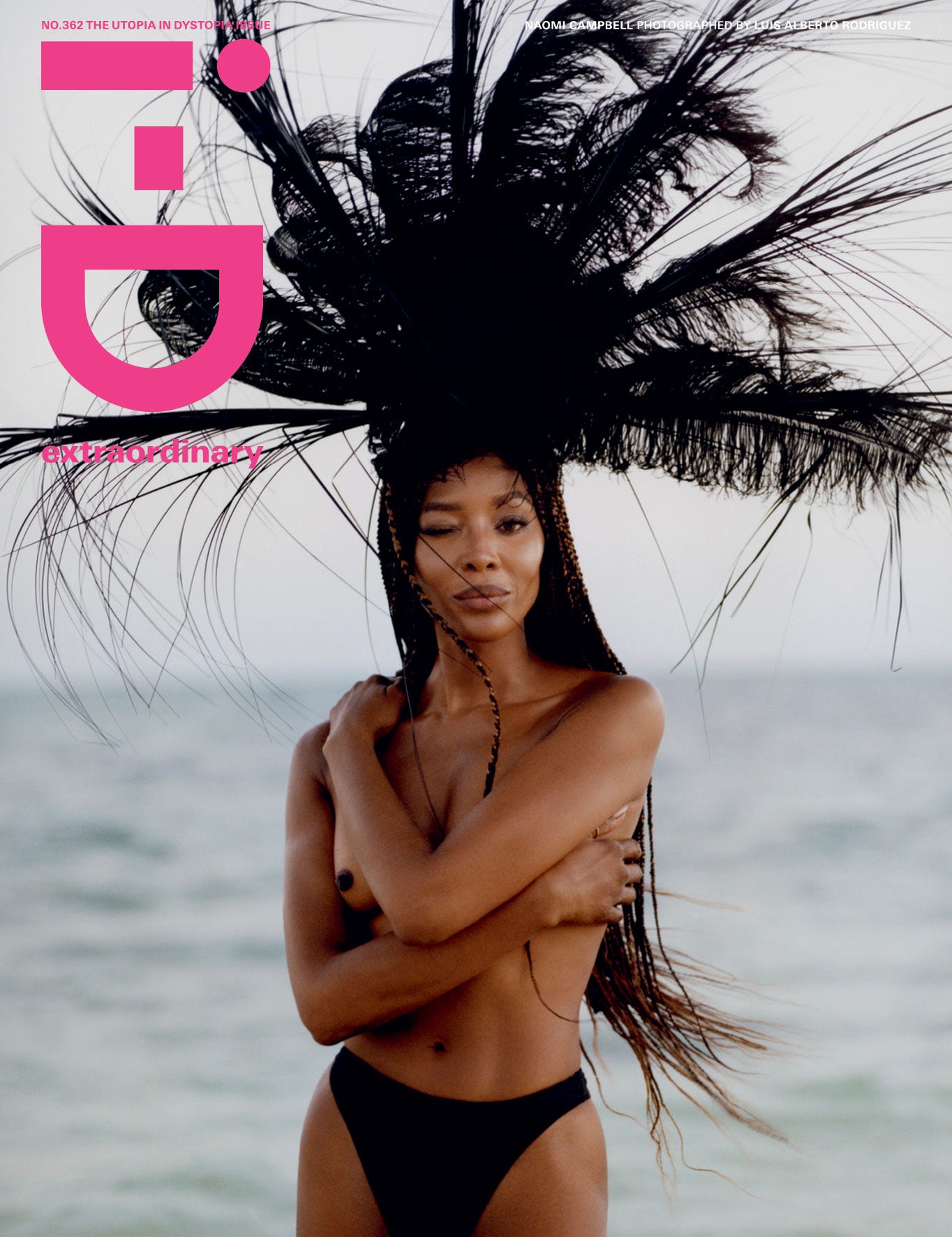
There was a lot of discussion about magazine covers this week, which is either a positive sign for the publishing industry or proof that we all need to go back outside. The focal point of the ~discourse~ was a recent slate of W Magazine covers lensed by the photographer Juergen Teller. Teller is well known for having a raw or more “authentic” approach to fashion imagery — a sort of anti-glossy that has made him the ideal collaborator for W and other magazines (as well as countless brands, like Marc Jacobs and JW Anderson) for decades.
The covers have a gritty quality to them that is exceptional, even by Teller’s standards. He photographed celebrities on a New York City street, with cars and garbage around. With the exception of the clothing, there’s nothing glamorous about the shoot—even the actors’ expressions are either caught off guard, dazed, or confused. On top of that, the pictures look like they could have been taken on an iPhone—the sort of quick snaps you get in those more intimate moments with friends. Presumably, this was the point: a stylistic choice made by the editors and the photographers to convey the “mood of the moment” (ie: Zoom awards shows, selfie red carpet photos, etc.) while still making something worthy of a magazine cover.
Immediately, people on social media unleashed their jokes. A Change.org petition circulated, urging fashion magazines to only hire Teller if he used film. Countless tweets parodied the visual formula, becoming the meme of the week—and thus, suffering the fate of becoming a viral Buzzfeed article.
I worked in magazines for about a decade, and for a considerable portion of that time, I was involved in the meetings and decision-making that surrounded cover shoots. I have agonized over few things in my career like a cover image. There are endless mock-ups, there’s incessant nit-picking over type and color adjustments, and then there are the scores of phone calls begging a celebrity’s team to align with your vision. Now more than ever, covers are a collaboration between editors and publicists; celebrities no longer need a magazine to tell their story or to broker their relationships with the fashion industry. (They have their own Instagram accounts for that.) Magazines have thus engaged in a (sometimes pitiful) song-and-dance to maintain their relevance as the chief image makers — enter digital covers, multiple cover subjects per issue, and “brand collaborations” that border on sponsored content.
Maybe in another timeline, I could write about the journalistic ethics of all of this. The bottom line about all of it, though, is…the literal bottom line. Being an editor-in-chief in 2021 means you’re showing up to work every day to justify your magazine’s existence to the public and to the men (they are always men, often conservative straight white men) who oversee your budgets. There is always a CEO who points out that another magazine, another website, or another social media brand is doing things cheaper, bigger, faster. They roll their eyes at phrases like “pay equity” and “employee burnout.” It becomes the editor’s job to constantly figure out how to compromise in an effort to keep the lights on and—while doing so—hopefully create something that makes it all worth it.
It was this feeling I remembered when I saw people mocking the W covers. (The magazine’s editor-in-chief, for full disclosure, is an acquaintance of mine—but I think I’d feel the same if she wasn’t.) Once the tweets started surfacing in every single one of my group chats, though, my perspective started to shift.
Obviously, the best-case scenario for any magazine cover is praise. You want the public to adore your images, to rush to the newsstand to buy them. That seemed to be the reaction to Vanity Fair’s surrealist Hollywood portfolio, or the i-D cover of Naomi Campbell, resplendent in Kenya. Those covers—while absolutely excellent—followed a formula that we have come to expect from magazines. The images are either outlandish and escapist (Vanity Fair) or impossibly beautiful and aspirational (i-D). Teller’s images for W do something very different—a sort of fashion-meets-verité approach that is well aware of its own contradictions. Teller’s images tend to have a sense of humor, or a bracing honesty that places glamour in a more vulnerable context.
While watching the social media discourse unfold, I wondered whether, while we’re all stuck at home and bored of our routines, we are craving more from our magazines—not less. Some publications practically stumbled over themselves to be a mirror to this moment, fearful of invoking luxury or glamour at a time of immense grief and struggle. But these very sudden content pivots nearly always missed the mark. In trying to “meet the moment,” it felt like most magazines were being too try-hard at best, and disingenuous at worst. (Just how many of their Instagram feeds featured only Black people during the Black Lives Matter protests—after years of their pages doing the exact opposite?) Don’t get me wrong: While it’s important for any publication to reflect the culture, we don’t necessarily need every magazine to be everything at once. The better methodology might be: What do we stand for, and how do we do it better than ever?
Sometimes escape is more necessary than reality, fantasy more inspiring than authenticity—especially when all your readers can see around them is the worst of the real world. In this way, maybe a fashion magazine is better advised right now to really go the distance—to create images that shock, provoke, and amaze, rather than reflect the everyday.

On the other hand, a part of me felt that what was happening all over the internet was a form of celebration on its own. I wondered if there was a world where a serious, glossy fashion magazine like W would ever break the fourth wall and acknowledge or embrace the jokes on social media—kind of like the magazine version of Elizabeth Warren joining Kate McKinnon (as Elizabeth Warren) on SNL. Parody is the cousin of praise—it doesn’t feel nearly as good, but it’s still commendable. All over my timeline, I saw people talk about W and Juergen Teller, and I thought: Did any of these people read W recently before these covers dropped? Did any of them care about Juergen Teller’s work at all? These questions were moot. Now, people were talking about both—and in an attention-driven economy, that’s worth something. At a time when fashion magazines are desperately scrambling for relevance, W became the nationwide trending topic of the week, earning the eyeballs of everyone from jaded fashion critics to Gen Z meme accounts.
Fashion always fumbles moments like these, mostly because we live in fear that nobody takes us seriously. This past week was proof that people do, in fact, take us seriously. It’s we who need to lighten up.




